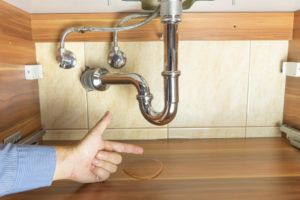
Causes of a Bathroom Flood
Clogs
This is also known as the “overflowing toilet” problem. The reason why a clogged pipe can make your toilet flood your bathroom is fairly straightforward: when you flush, all that water has to go somewhere. If it can’t, it goes back up and, possibly, over the bowl entirely. Clogs can result from flushing a large mass of toilet paper, flushing something down the toilet that isn’t supposed to go through the pipes (cooking fat, hair, underwear, etc.), or even flushing a particularly large mass of feces. If a clog does develop, make use of a toilet plunger or auger to clear the obstruction before trying to flush again.
Fixture Leaks
If a faucet, drain, toilet tank, tub, or other fixture has a loose element (the fixture itself, a valve, drain, etc.) or crack somewhere, water can seep out. This usually presents with the appearance of mysterious puddles and can lead to infiltration of surrounding surfaces if left unaddressed. The puddles will usually appear near the leaking fixture, but in small bathrooms, proximity alone can implicate multiple suspects. One way to help find the source is to add food colouring to the suspected fixture (the toilet tank, for instance). If puddle changes colour, you have your source and can get it checked by a plumber.
Burst Pipe
This is one of the worst-case scenarios as far as flooding is concerned. Burst pipes happen most often in the winter due to the water within freezing and expanding. They can also happen if a pipe is neglected for too long and develops rust or corrosion. The more exposed a pipe is, the more vulnerable it can be to bursting. For your bathroom, this usually means the pipes under the sink. Fortunately, it is possible to take preventive measures to keep your pipes from flooding the bathroom floor and beyond. If there are visible pipes in your bathroom, take a look at them every now and then for signs of corrosion and replace parts as needed. In the winter, if you are going to be leaving the home for several days, open a faucet a little bit and let a trickle of water through. This will keep water moving through the pipes, and running water is much harder to freeze.
What to Do When Your Bathroom is Flooded
When you discover flooding in the bathroom, prompt action is the best way to ensure your home suffers as little damage as possible. First and foremost, you should be shutting off the water in order to limit the flow of damage and give a clean-up a chance. Afterwards, the exact steps you follow will depend on personal circumstances, but there are a few constant pieces of advice to keep in mind:
- Avoid touching or standing in water from a flooding toilet
- If you have towels, lay them down to help absorb some of the water. If the rooms connecting to the bathroom have sensitive flooring materials (like hardwood), place the towels along the door frame as a buffer
- Contact a flood clean-up service, especially if the flooding is severe or may have infiltrated flooring or walls
- Do not enter the room if the water has reached an electrical outlet or device. This doesn’t come up as often with bathrooms, but it is still worth remembering
- If you intend to clean up the water yourself, wear shoes that offer a good grip. Bathroom tiles are resistant to water infiltration, so pooling and puddles are more common
- Once the water is cleaned, consider contacting a plumbing professional to find the source of the flooding
Contact Flood Services Canada for Professional Bathroom Flood Clean-up and Restoration
Bathroom flooding can be a dramatic and stressful event. Should you end up facing a bathroom flood, professional remediation can be used to fix the problem, dry your floors, and thoroughly inspect your floors and walls for damp patches and mould. When facing water damage, Flood Services Canada’s quick response teams of professional remediators will drain, dry, and save your property.
Contact us at 416-302-2107 for more information about bathroom floods, or use our emergency hotline at 416-999-3930 to get our rapid response teams deployed to your location.
